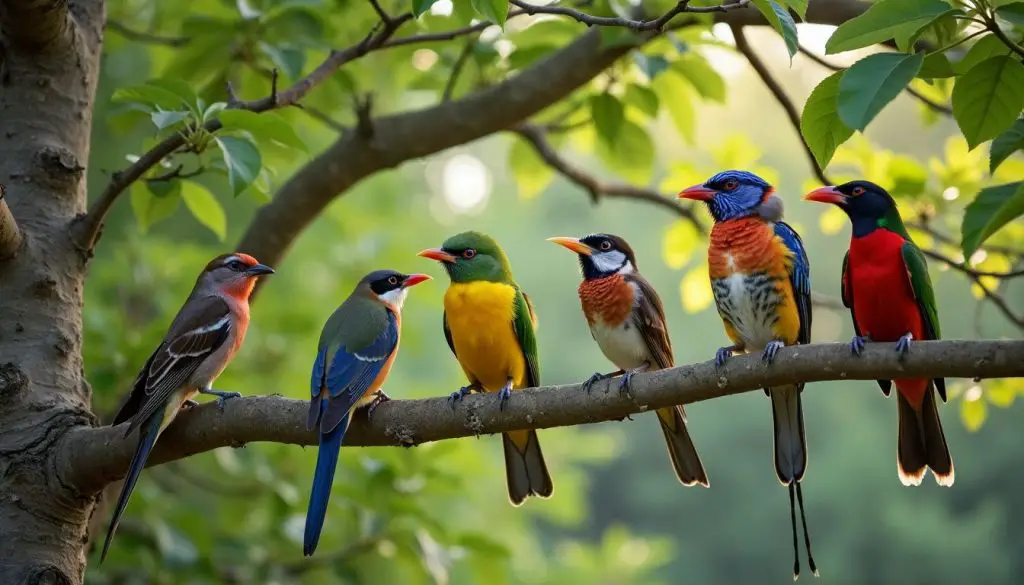Exploring the Variety of Long Island Birds: Discovering the Diverse Bird Species
Finding information on Long Island birds can be overwhelming. Did you know that Long Island is home to a vast variety of bird species? This article will guide you through identifying and appreciating these diverse creatures.

Key Takeaways
- Long Island is home to a wide range of bird species, including songbirds, birds of prey, and shorebirds. These birds live in various habitats across the island.
- Important Bird Areas (IBAs) on Long Island are crucial for bird conservation. They offer safe nesting sites and abundant food sources for many resident and migratory birds.
- Birdwatching is a popular hobby on Long Island. By learning identification techniques and participating in local birdwatching groups, people can enjoy observing diverse avian life.
- Backyard birding can attract different types of birds to your home. Installing feeders, water features, and planting native plants are effective ways to observe birds up close.
- Conservation efforts by organizations like the Audubon Society help protect the habitats of these diverse bird species. Volunteers contribute by planting native vegetation and monitoring populations.
Diverse Bird Species of Long Island
Long Island hosts a rich variety of bird species. You can spot vibrant songbirds, powerful birds of prey, and fascinating shorebirds that thrive in this unique habitat.
Songbirds
Songbirds fill the skies of Long Island with their beautiful melodies. These small, colorful birds belong to the order Passeriformes. They are known for their singing abilities, which attract mates and establish territory.
Many songbird species, such as the Eastern Bluebird and the American Robin, thrive in various habitats across the island.
Birdwatching aficionados often enjoy spotting these lively creatures. Birdwatching allows you to connect with nature while observing their fascinating behaviors. Techniques like using binoculars can enhance your bird identification skills.
Enjoying backyard birding with feeders can also attract songbirds to your home.
The beauty of songbirds reminds us of the importance of biodiversity.
Birds of prey
Long Island hosts a variety of birds of prey. These majestic raptors include hawks, eagles, and owls. You can find the red-tailed hawk soaring above the fields. Its sharp eyesight helps it spot small animals below.
The osprey, another impressive bird, hunts for fish along the coasts. This bird often nests on platforms built for its protection.
Owls, such as the great horned owl, are fascinating as well. They hunt at night and have excellent hearing for locating prey. The diverse habitats of Long Island support these birds of prey.
They rely on healthy ecosystems for food and nesting sites. Bird watching enthusiasts often seek these raptors for their breathtaking displays. Many enjoy capturing their beauty through wildlife photography.
Understanding their habits can enhance your birding experience on Long Island.
Shorebirds
Shorebirds thrive along Long Island’s coast. Species like sandpipers, plovers, and oystercatchers dot the sandy beaches and wetlands. These birds rely on both habitats for feeding and nesting.
They often forage for food in the mudflats and shallow waters. During migration, you can spot many shorebirds as they travel long distances. Their varied diets include insects, mollusks, and crustaceans.
Visiting Important Bird Areas (IBAs) like Jamaica Bay or Montauk Point offers great opportunities for birdwatching. These hotspots attract nature enthusiasts who enjoy observing these elegant travelers.
Birdwatching on Long Island allows you to witness the beauty of shorebirds in their natural habitat. Embrace this birding hobby and appreciate the diversity of these remarkable species.
Importance of Important Bird Areas (IBAs)
Important Bird Areas (IBAs) serve as crucial habitats for many bird species. These areas support conservation efforts and create prime locations for birdwatching enthusiasts to observe diverse avian life.
Conservation efforts
Conservation efforts on Long Island play a crucial role in protecting diverse bird species. Organizations like the Audubon Society actively work to preserve bird habitats. They focus on important bird areas (IBAs) that support many migratory and resident birds.
These areas provide safe nesting sites and rich food sources.
Volunteers and local communities often participate in bird conservation projects. They plant native vegetation and monitor bird populations. Every action counts in maintaining the balance of ecosystems.
By joining these efforts, you can support bird conservation on Long Island and enjoy your bird watching hobby even more.
Hotspots for birdwatching
Long Island has several exceptional hotspots for birdwatching – even abandoned places on Long Island. Places like Jamaica Bay Wildlife Refuge and Montauk Point State Park attract bird lovers year-round. You can spot various species of shorebirds and songbirds in these areas.
Many migratory birds visit during their seasonal journeys. Armed with a birding checklist, you can track which species you see.
Participating in local birding events can enhance your experience. Joining guided tours provides unique insights into the behaviors of different birds. Bring binoculars and a field guide for identifying birds along the coast.
These hotspots offer great opportunities for discovering the vibrant birdlife of Long Island.
The Art and Hobby of Birdwatching
Birdwatching offers you a chance to connect with nature. You can improve your skills by learning bird identification techniques and observing local species in your backyard.
Techniques for bird identification
You can enjoy birdwatching on Long Island by using various techniques for bird identification. These skills will help you recognize different species and enhance your overall experience.
- Observe Colors and Patterns
Notice the colors and patterns of each bird. Bright plumage often helps identify songbirds like the Eastern Bluebird. Unique markings, such as stripes or spots, distinguish many species.
- Listen to Songs and Calls
Familiarize yourself with different birds’ songs and calls. For example, the sweet whistle of the American Robin is easy to remember. Listening carefully can help you spot elusive species that stay hidden in trees.
- Study Size and Shape
Pay attention to a bird’s size and shape. The compactness of a sparrow differs from the slender form of a heron. Comparing these characteristics aids in quick identification.
- Look at Behavior
Watch how birds behave in their environment. Feeding habits, flight patterns, and social interactions reveal valuable information about the species. For instance, see how owls hunt silently compared to the active foraging of chickadees.
- Use Field Guides or Apps
Utilize field guides or mobile apps specific to Long Island birds for accurate identification techniques. Many resources provide pictures, descriptions, and sounds that assist you in recognizing common species quickly.
- Join a Birdwatching Group
Engage with local birdwatching groups for shared knowledge and experience in ornithology. Members often share tips on spotting rare birds at popular birding hotspots around Long Island.
- Keep a Bird Journal
Maintain a journal of your observations during your outings. Jot down details like date, location, weather conditions, and sightings for better understanding over time.
- Practice Patience
Develop patience during your birdwatching adventures. Birds may take time to appear or might require quiet moments before they feel safe enough to show themselves.
These techniques will enrich your visits to Long Island’s Important Bird Areas (IBAs) while also creating awareness about conservation efforts within these unique habitats.
Tips for backyard birding
Backyard birding offers a rewarding way to connect with nature. Long Island boasts a rich variety of birds, making your yard the perfect observation spot.
- Provide Food Sources: Different birds have varied diets. Use feeders filled with seed mixes, suet, or nectar to attract songbirds and hummingbirds.
- Create Water Features: Birds need water to drink and bathe. Install a birdbath or small fountain in your yard to draw in a wide range of species.
- Offer Shelter Options: Birds look for safe places to rest and nest. Plant native shrubs and trees, or put up birdhouses to give them shelter.
- Plant Native Flora: Native plants support local insects, which many birds rely on for food. Choose flowers, shrubs, and trees that are indigenous to Long Island for the best results.
- Minimize Disturbances: Keep noise levels low to avoid scaring off birds. This peaceful environment encourages them to visit more often.
- Practice Birdwatching Techniques: Use binoculars for a closer view of distant birds. Identify species by observing their colors, shapes, and behaviors.
- Record Your Sightings: Keep a journal of the bird species you observe in your backyard. This will help track migration patterns and improve your identification skills over time.
- Engage Family and Friends: Invite others to join you in birdwatching activities at home or nearby parks. Sharing this experience spreads awareness about the importance of conserving Long Island’s diverse bird species.
- Stay Aware of Seasonal Changes: Bird migration impacts which species visit your backyard throughout the year. Stay informed about seasonal patterns to maximize sightings during migration periods.
- Support Local Conservation Efforts: Join or donate to organizations focused on protecting birds in Long Island’s Important Bird Areas (IBAs). Your contribution helps maintain habitats for various bird species while enhancing birdwatching opportunities in the area.
Use these tips for backyard birding effectively as you explore the variety of Long Island birds around you!
Conclusion and Call to Action for Bird Conservation on Long Island
Exploring Long Island’s diverse bird species brings joy and wonder. You will find songbirds singing, majestic birds of prey soaring, and shorebirds wading along the coast. Each sighting enriches your experience and deepens your appreciation for nature.
Get involved in conservation efforts to protect these vital habitats. Your actions can make a difference in preserving these beautiful birds for future generations.
FAQs
1. What does exploring the variety of Long Island birds entail?
Exploring the variety of Long Island birds involves discovering and studying the diverse bird species that inhabit this region.
2. How many different bird species can I expect to find on Long Island?
Long Island is home to a wide range of bird species, showcasing an incredible diversity in its avian population.
3. Are there unique or rare bird species found only on Long Island?
Yes, when you explore the variety of birds on Long Island, you’ll discover several unique and rare species that are specific to this region.
4. Is it beneficial for researchers and enthusiasts to study the diverse bird species on Long Island?
Absolutely! Studying the diverse bird species found while exploring Long Island can provide valuable insights into their behaviors, habitats, and roles in maintaining ecological balance.
5. How did the underground fires affect bird habitats?
The Nassau underground fires have damaged the soil, vegetation, and trees where birds nest and feed. This destruction may lead to displacement, forcing birds to relocate to safer areas, potentially affecting their breeding and survival.
6. Are birds a pest?
Birds are not a Long Island pest that needs to be controlled.






